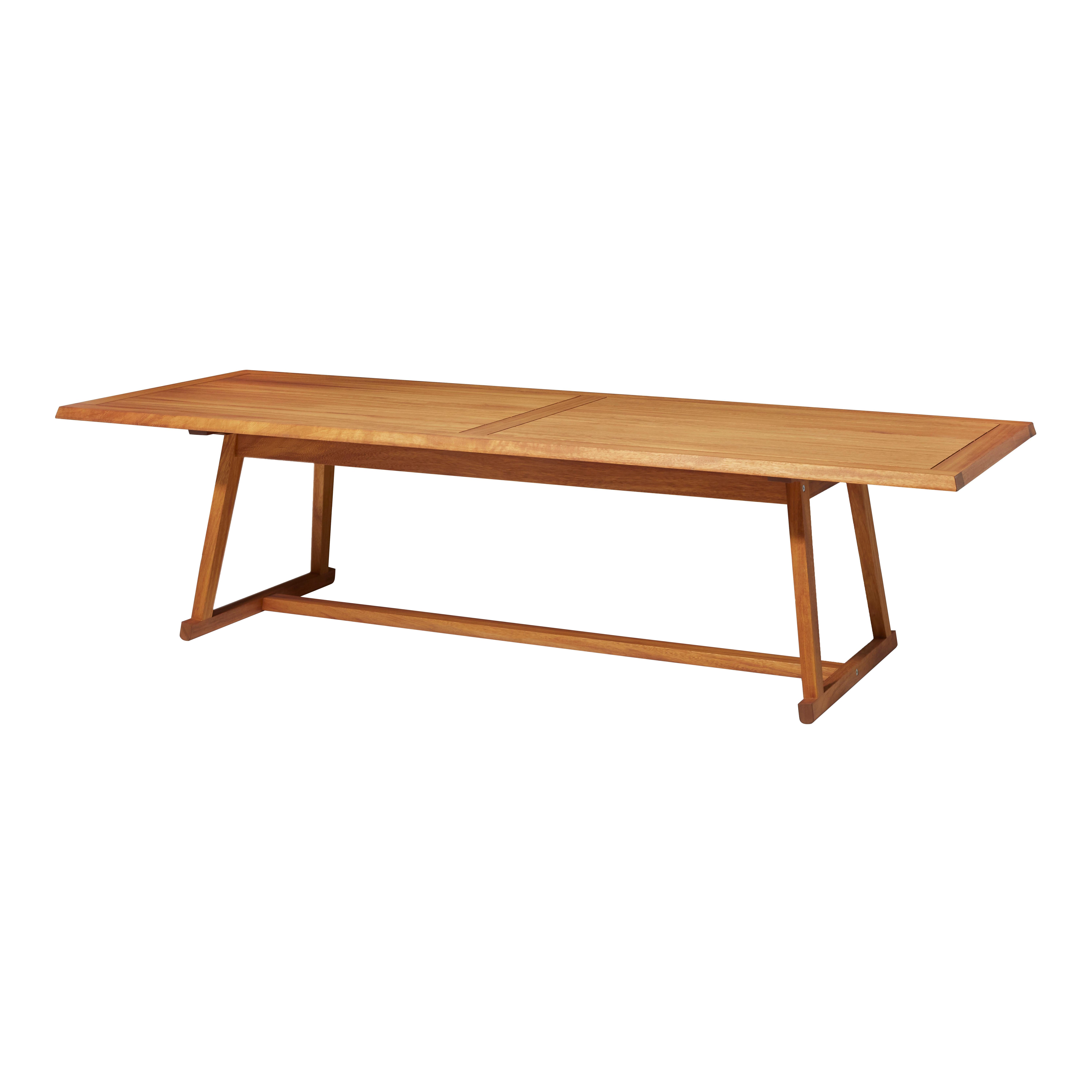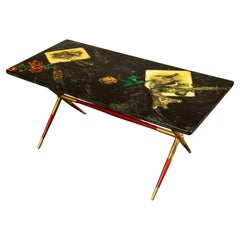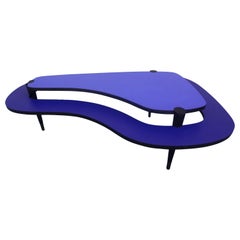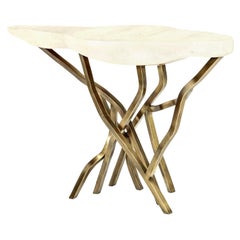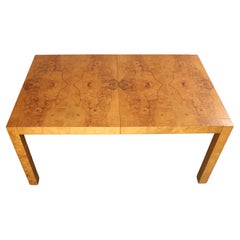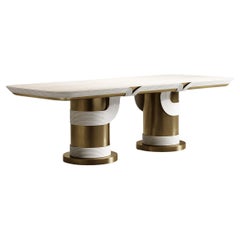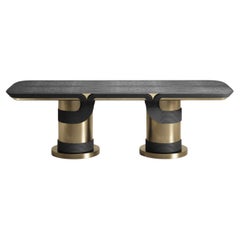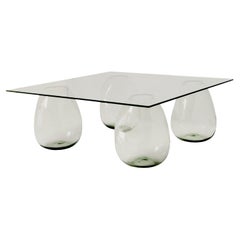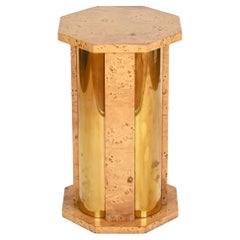Tables
to
1,896
Height
to
Width
to
Depth
to
8,936
6,751
9,944
7,311
259
3,855
2,463
557
376
231
209
186
173
155
136
122
115
92
74
73
40
31
15
604
1,751
4,955
10,203
681
2,211
1,296
104
25
145
209
178
497
642
712
202
51
9,781
7,874
3,230
2,361
2,241
11,459
3,949
2,883
2,266
2,044
17,514
8,407
10,556
282
152
151
141
128
Tables For Sale
Shagreen Sculptural Dining Table in Shagreen Rattan and Brass by R&Y Augousti
Located in New York, NY
The Paris based label has distinguished themselves since their launch, with their iconic use of shagreen mixed with brass and other exotic materials. All furniture is handcrafted by ...
Category
21st Century and Contemporary Philippine Art Deco Tables
Materials
Brass
Shagreen Sculptural Dining Table in Shagreen Rattan and Brass by R&Y Augousti
Located in New York, NY
The Paris based label has distinguished themselves since their launch, with their iconic use of shagreen mixed with brass and other exotic materials. All furniture is handcrafted by ...
Category
21st Century and Contemporary Philippine Art Deco Tables
Materials
Brass
Italian Mid Century Modern Piero Fornasetti "Caccia" Coffee Table Milan 1955
Located in Portland, OR
An important Italian Mid Century lacquered wood & brass, hand-painted & transferred coffee table, designed by Piero Fornasetti (1913-1988) in the "Caccia" pattern, 1955.
This fabulou...
Category
Mid-20th Century Italian Mid-Century Modern Tables
Materials
Brass
Bubble glass coffee table
Located in Ciudad de México, CDMX
The Bubble Glass Coffee Table embodies a retro-futuristic fantasy. Inspired by past visions of the future, it draws from mysterious tales of speculative technologies and flying sauce...
Category
2010s Mexican Post-Modern Tables
Materials
Glass
Shagreen Sculptural Side Table with Shell and Brass Details by R&Y Augousti
Located in New York, NY
The Paris based label has distinguished themselves since their launch, with their iconic use of shagreen mixed with brass and other exotic materials. All furniture is handcrafted by ...
Category
21st Century and Contemporary Philippine Art Deco Tables
Materials
Brass
Tommaso Barbi Octagonal Side Table Pedestal in Brass and Birch Burl, Italy 1970s
Located in Roma, IT
Incredible octagonal pedestal table in brass and birch burl. This incredibly stylish and versatile piece was designed by Tomasso Barb and produced in Italy during the 1970s. Signed o...
Category
Mid-20th Century Italian Mid-Century Modern Tables
Materials
Brass
Danish Mid Century Modern, Long Bench in Solid Oak, Henning Kjærnulf, 1960s
Located in Odense, DK
This rare and sculptural oak bench was designed by a Danish cabinetmaker in the 1950s. Attributed to Henning (Henry) Kjærnulf. Crafted entirely from solid oak, the piece is character...
Category
Mid-20th Century Danish Scandinavian Modern Tables
Materials
Oak
Shagreen Side Table with a Sculptural Bronze Patina Brass Base by R&Y Augousti
Located in New York, NY
The Paris based label has distinguished themselves since their launch, with their iconic use of shagreen mixed with brass and other exotic materials. All furniture is handcrafted by ...
Category
21st Century and Contemporary Philippine Art Deco Tables
Materials
Brass
Shagreen Sculptural Side Table with Shell and Brass Details by R&Y Augousti
Located in New York, NY
The Paris based label has distinguished themselves since their launch, with their iconic use of shagreen mixed with brass and other exotic materials. All furniture is handcrafted by ...
Category
21st Century and Contemporary Philippine Art Deco Tables
Materials
Brass
Shell Inlaid Side Table with Sculptural Bronze Patina Brass Frame by KIFU PARIS
Located in New York, NY
The Paris based label has distinguished themselves since their launch, with their iconic use of shagreen mixed with brass and other exotic materials. All furniture is handcrafted by ...
Category
21st Century and Contemporary Philippine Art Deco Tables
Materials
Brass
Shagreen Side Table with a Sculptural Bronze Patina Brass Frame by KIFU PARIS
Located in New York, NY
The Paris based label has distinguished themselves since their launch, with their iconic use of shagreen mixed with brass and other exotic materials. All furniture is handcrafted by ...
Category
21st Century and Contemporary Philippine Art Deco Tables
Materials
Brass
Artona dining table by Afra & Tobia Scarpa, produced by Maxalto Italy, 1970
Located in Piacenza, Italy
Artona dining table by Afra & Tobia Scarpa, produced by Maxalto
Elegant dining table from the Artona series, designed by Afra & Tobia Scarpa.
Crafted with a solid walnut wood struct...
Category
1970s Italian Mid-Century Modern Vintage Tables
Materials
Wood
French Marble Top & Walnut Coffee Table Celina Decoracões Style, circa 1960
Located in Labrit, Landes
French marble top and walnut coffee table in the Celina Decoracões style.
Made in the 20th Mid-century period.
Marble multicolor, with green and pink highlights
Table height: 13.78 ...
Category
1960s French Mid-Century Modern Vintage Tables
Materials
Marble
Shell Inlaid Side Table with Sculptural Bronze Patina Brass Base by R&Y Augousti
Located in New York, NY
The Paris based label has distinguished themselves since their launch, with their iconic use of shagreen mixed with brass and other exotic materials. All furniture is handcrafted by ...
Category
21st Century and Contemporary Philippine Art Deco Tables
Materials
Brass
Customizable ClassiCon Bow Coffee Table by Guilherme Torres
Located in New York, NY
Inspired by 1970s lines and designs, Brazilian Guilherme Torres presents a side table or coffee table of casual elegance. The metal-covered surface of the body also quotes futuristic...
Category
21st Century and Contemporary German Modern Tables
Materials
Brass
Spanish Pair of Nightstand Bedside Table Oak, Midcentury
Located in Labrit, Landes
Pair of spanish nightstands, bedside tables
chestnut and wrought iron.
One drawer.
Good original condition
Shipping:
65 / 44 / 47 cm 11.2 kg
Category
Mid-20th Century Spanish Mid-Century Modern Tables
Materials
Chestnut
Echo Coffee Table in Penny Red, Translucent Polyurethane Resin, Ian Cochran
By Ian Cochran
Located in New York, NY
Echo coffee table by Ian Alistair Cochran Represented by Tuleste Factory
Solid Resin
W 40" x H 18.5" x D/L 40"
W 101.6 x H 47 x D/L 101.6 cm
A continuation of the Echo series, th...
Category
2010s Tables
Materials
Resin
Tavolo Pranzo Decoro Scagliola Foglia Oro Basi Scolpite Fatto a Mano da Cupioli
Located in Rimini, IT
Tavolo pranzo decoro scagliola foglia oro basi scolpite fatto a mano da Cupioli.
Il Tavolo Rettangolare è composto da un piano artisticamente decorato con la tecnica della scagliola...
Category
21st Century and Contemporary Italian Modern Tables
Materials
Scagliola, Wood
Original of the Time Josef Hoffmann Jacob&Josef Kohn Coffee Table
Located in Vienna, AT
A petite coffee table by Josef Hoffmann from 1905 made by J&J Kohn in beechwood.
Category
Early 20th Century Austrian Jugendstil Tables
Materials
Beech
Piano desk black lacqued wood
Located in Ciudad de México, CDMX
A sleek, black-polished, sculptural piece conjuring the presence of a grand piano.
Piano Desk evokes an intricate fusion of the grace in artistic expressi...
Category
2010s Mexican Post-Modern Tables
Materials
Wood
$8,400 / item
Bubble glass coffee table
Located in Ciudad de México, CDMX
The Bubble Glass Coffee Table embodies a retro-futuristic fantasy. Inspired by past visions of the future, it draws from mysterious tales of speculative technologies and flying sauce...
Category
2010s Mexican Post-Modern Tables
Materials
Glass
Gilbert Poillerat Coffee Table Base in Gilt Iron, France 1940s
Located in Barcelona, ES
Beautiful Gilbert Poillerat wrought iron low table base. France, 1940s.
The original marble top from this table was missing so we are presenting it as a table base without the top. M...
Category
Mid-20th Century French Art Deco Tables
Materials
Iron, Wrought Iron, Gold Leaf
Bistro Table or Entry Table in Aged Brass Finish
Located in Old Town Orange, CA
Aged Patina brass finish, this table works well as a bistro table, or use as an entry center table.
The top has a wonderful aged patina, and the finish is of an aged brass.
Size: 31-...
Category
21st Century and Contemporary Tables
Materials
Metal
$1,498 / item
Pair of Midcentury Chromed Steel Italian Trestles After Milo Baughman, 1970s
Located in Roma, IT
Gorgeous pair of midcentury trestles fully made in chromed steel. These incredibly stylish trestles were designed in Italy after Milo Baughman during the 1970s.
These versatile tres...
Category
Mid-20th Century Italian Mid-Century Modern Tables
Materials
Steel, Chrome
Midcentury Italian Trestle Desk or Table in Bamboo, Rattan by Vivai Del Sud, 70s
Located in Roma, IT
Wonderful pair of mid-century organic trestles in a beautiful combination of bamboo, curved rattan and hand-woven wicker. These stunning and unique trestles were designed by Vivai del Sud and produced in Italy during the 1970s.
In fabulous condition and with an amazing honey-like color. These sturdy trestles are made in bamboo canes enriched on the bottom with curved rattan and perfect hand-woven wicker work.
Ideal to make a charming desk or also for dining table or a console table in a modern organic entryway. A must have for all the French Riviera style lovers.
These versatile trestles are ideal as a charming modern organic desk...
Category
Mid-20th Century Italian Mid-Century Modern Tables
Materials
Bamboo, Rattan, Wicker
Oak Morro Table by Lawson-Fenning
Located in Los Angeles, CA
Morro table by Lawson-Fenning. The Morro table features a series of geometric shapes stacked on top of each other with solid wood details. Available in American walnut or white oak. ...
Category
2010s American Mid-Century Modern Tables
Materials
Oak
$2,185 / item
Echo Coffee Table in Deep Olive, Translucent Polyurethane Resin, Ian Cochran
By Ian Cochran
Located in New York, NY
Echo coffee table by Ian Alistair Cochran Represented by Tuleste Factory
Solid Resin
W 40" x H 18.5" x D/L 40"
W 101.6 x H 47 x D/L 101.6 cm
A continuation of the Echo series, th...
Category
2010s Tables
Materials
Resin
Echo Coffee Table in Bold Blue, Translucent Polyurethane Resin, Ian Cochran
By Ian Cochran
Located in New York, NY
Echo coffee table by Ian Alistair Cochran Represented by Tuleste Factory
Solid Resin
W 40" x H 18.5" x D/L 40"
W 101.6 x H 47 x D/L 101.6 cm
A continuation of the Echo series, th...
Category
2010s Tables
Materials
Resin
Midcentury large coffee table by Willy Rizzo, Italy 1970
By Willy Rizzo
Located in Piacenza, Italy
Large coffee table by Willy Rizzo, Italy, 1970
Designed by celebrated Italian designer Willy Rizzo in the 1970s, this impressive large-scale coffee table combines refined materials w...
Category
1970s Italian Mid-Century Modern Vintage Tables
Materials
Brass
Warren Platner for Knoll Nickel Wire Dining Table
By Warren Platner, Knoll
Located in New York, NY
Warren Platner polished nickel dining table base by Knoll.
Includes non-original 60 inch wide clear tempered glass top— last photo shows actual table with glass top.
Circa 1990-200...
Category
Early 2000s American Mid-Century Modern Tables
Materials
Nickel
Early 20th Century French Zinc-Top Garden Table
Located in Chicago, IL
This early 20th-century French potting table, with its weathered zinc top and faux wood-grain painted finish, is the perfect blend of form and fun...
Category
Early 20th Century French Rustic Tables
Materials
Zinc
Italian Coffee Table in Maroon Leather w/ Bronze Glass by Massoni for Frau, '70s
Located in Roma, IT
Stunning low adjustable coffee table in spectacular full grain maroon colored Italian leather with a bronzed smoked mirror top. This incredibly stylish and unique table was designed ...
Category
1970s Italian Mid-Century Modern Vintage Tables
Materials
Metal
Butterscotch Spill Table Mono by Goons
Located in Geneve, CH
Spill Table Mono by Goons
Dimensions: W 148 x D 98 x H 32 cm
Materials: Birch plywood.
Butterscotch finish.
Dimensions can be adjusted +/- 10 cm
Goons is located in Paris, France. ...
Category
2010s French Post-Modern Tables
Materials
Wood
$5,538 / item
Shagreen Side Table with Sculptural Bronze Patina Brass Legs by R&Y Augousti
Located in New York, NY
The Paris based label has distinguished themselves since their launch, with their iconic use of shagreen mixed with brass and other exotic materials. All furniture is handcrafted by ...
Category
21st Century and Contemporary Philippine Art Deco Tables
Materials
Brass
Square Coffee Table Signed by Afra and Tobia Scarpa for Cassina, Italy 1960s
Located in Roma, IT
Stunning Mid-Century coffee table Model 771 in walnut wood designed by Afra and Tobia Scarpa and produced by Cassina, in Italy during the 1960s. The table is signed underneath one of...
Category
1960s Italian Mid-Century Modern Vintage Tables
Materials
Wood, Walnut
Shagreen Inlaid Console Table with Sculptural Brass Legs by R&Y Augousti
Located in New York, NY
The Paris based label has distinguished themselves since their launch, with their iconic use of shagreen mixed with brass and other exotic materials. All furniture is handcrafted by ...
Category
21st Century and Contemporary Philippine Art Deco Tables
Materials
Brass
Modern Sistelo Dining Table, Warm Grey Oak, Brass, Handmade by Greenapple
Located in Lisboa, PT
Mid-Century Modern Sistelo Dining Table, Contemporary Collection, Handcrafted in Portugal - Europe by Greenapple.
The Sistelo dining table draws inspiration from the terraced landsc...
Category
21st Century and Contemporary Portuguese Mid-Century Modern Tables
Materials
Brass, Stainless Steel
Shagreen Side Table with Sculptural Bronze Patina Brass Legs by R&Y Augousti
Located in New York, NY
The Paris based label has distinguished themselves since their launch, with their iconic use of shagreen mixed with brass and other exotic materials. All furniture is handcrafted by ...
Category
21st Century and Contemporary Philippine Art Deco Tables
Materials
Brass
Shagreen Foosball Table with Bronze-Patina Brass Accents R&Y Augousti
Located in New York, NY
The Damier Foosball Table by R&Y Augousti is a truly luxurious statement piece for your home. The retro-feel of the piece with the checkerboard inspired pattern mix of black shagreen...
Category
21st Century and Contemporary Philippine Art Deco Tables
Materials
Brass
French Round Dining Table Smoked Glass and Chrome, Mid-century
Located in Labrit, Landes
Round dining table with an elegant base polished steel and a smoked glass top.
The top is in very good condition: very few signs of use. The foot has a few very small traces of rust ...
Category
Mid-20th Century French Tables
Materials
Iron
Catalina Reclaimed Elm Wood Kitchen Island in Natural and Removable Shelf
Located in Old Town Orange, CA
Catalina Island
The most authentic materials are hand selected, and hours of hand-craftsmanship go into each piece, creating each and every beautiful table, no one is exactly alike. ...
Category
21st Century and Contemporary Tables
Materials
Elm, Reclaimed Wood
Italian Mid-Century ALVEO Coffee Cocktail Table, Willy Rizzo, circa 1970
By Willy Rizzo
Located in Vilnius, LT
Italian Willy Rizzo ALVEO series mid-century coffee table from 1970s.
This table is an exclusive piece created with burl walnut veneer decorated with brass details on the corners an...
Category
Mid-20th Century Italian Mid-Century Modern Tables
Materials
Brass
Mid Century Danish Modern Teak Executive Desk or Writing Table
Located in Philadelphia, PA
A wonderful and simply designed teak desk from Scandinavia circa 1970's. It features teak construction with finished back. Clean & ready to use condition. No drawer keys present but ...
Category
1970s Danish Scandinavian Modern Vintage Tables
Materials
Teak
Pair of Frank Lloyd Wright Taliesin Tables for Henredon
Located in Las Vegas, NV
Super RARE and early Mid Century set of 2 tables from the Taliesin Collection by Frank Lloyd Wright for Heritage-Henredon.
1 coffee table (33" square x 15.75" high) also available. ...
Category
20th Century Mid-Century Modern Tables
Materials
Mahogany
Quartz Inlaid Side Table with Sculptural Brass Legs by R&Y Augousti
Located in New York, NY
The Paris based label has distinguished themselves since their launch, with their iconic use of shagreen mixed with brass and other exotic materials. All furniture is handcrafted by ...
Category
21st Century and Contemporary Philippine Art Deco Tables
Materials
Quartz, Brass
Modern Mexican Ebony Round Dining Table
Located in PARQUE INDUSTRIAL OTHON P BLANCO, Quintana Roo
A simple yet classic piece, crafted from Katalox wood – Mexican Ebony. The wood’s natural dark purple tone gives the table a lot of character, while its curved shapes add refinement....
Category
2010s Mexican Modern Tables
Materials
Hardwood, Walnut
$7,500 / item
Early 19th Century Cherry Hand-Planed Gate-Legged, Drop Leaf Dining Table
Located in Louisville, KY
Not your ordinary drop-leaf table, this early 19th century cherry gate-leg, drop-leaf table was hand-planed and hand-turned to create a wonderful dining table that doubles as a conso...
Category
Early 19th Century American Federal Antique Tables
Materials
Cherry
Paul Evans Signed & Dated Rectangular Sculpted Bronze and Glass Cocktail Table
By Paul Evans
Located in New York, NY
This beautiful and iconic Brutalist sculpted bronze "Stalagmite" was realized by the fabled designed Paul Evans in in 1970. It features a welded sculptural and heavily textured bronz...
Category
1970s American Mid-Century Modern Vintage Tables
Materials
Bronze
Frank Lloyd Wright Taliesin Coffee Table for Henredon
Located in Las Vegas, NV
Super RARE and early Mid Century set of 2 tables from the Taliesin Collection by Frank Lloyd Wright for Heritage-Henredon.
1 coffee table (33" square x 15.75" high) also available. ...
Category
20th Century Mid-Century Modern Tables
Materials
Mahogany
Shagreen Coffee Table with Bronze Patina Brass Details by Kifu Paris
Located in New York, NY
The Paris based label has distinguished themselves since their launch, with their iconic use of shagreen mixed with brass and other exotic materials. All furniture is handcrafted by skilled artisans, ultimately making each piece unique, designed in Paris and produced in the Philippines.
The Mask Coffee Table...
Category
2010s Philippine Art Deco Tables
Materials
Quartz, Brass
Italian unique example of a handcrafted dining table
Located in Traversetolo, IT
This beautiful dining table is a unique piece, crafted by skilled cabinetmakers as a single copy, using elegant teak wood. In its simplicity, it blends classic and modern elements, w...
Category
2010s Italian Modern Tables
Materials
Brass
Cocktail Table Serie 97 – Sereno by NONO for Contemporary Interiors
Located in Ciudad de México, CDMX
Cocktail Table Serie 97 – Sereno by NONO for Contemporary Interiors
———
Sereno Coffee Table Series – A Note from Joel Escalona
What happens when structure becomes art?
These are...
Category
2010s Mexican Brutalist Tables
Materials
Hardwood
$8,952 Sale Price / item
25% Off
Vintage Regency Style Mahogany Rotating Drum Tooled Leather Top Rent Table
Located in West Chester, PA
A splendid Regency-style mahogany drum table with tooled leather top above rotating drum of eight drawers and four open shelves all on a pedestal base with carved mahogany legs and b...
Category
Early 20th Century American Regency Tables
Materials
Leather, Mahogany
Midcentury Giovanni Offredi "Paracarro" Dining Table, Italy 1973
Located in Roma, IT
Unique "Paracarro" model dining table designed by Giovanni Offredi and produced by Saporiti in Italy during 1973.
Based on a prototype project, it has a peculiar dome-shaped concret...
Category
1970s Italian Mid-Century Modern Vintage Tables
Materials
Concrete, Steel, Chrome
Acerbis LOKUM Coffee Table in smoked grey by Sabine Marcelis
Located in Brooklyn, NY
Matter, light and colour come together in an intense interaction
of materials.
This collection embodies the elegance of pure forms, elevated
through the use of hand-blown glass. Sabi...
Category
21st Century and Contemporary Italian Tables
Materials
Glass, Art Glass
Shell Dining Table Set with Two Sculptural Chairs by R&Y Augousti
Located in New York, NY
The Paris based label has distinguished themselves since their launch, with their iconic use of shagreen mixed with brass and other exotic materials. All furniture is handcrafted by ...
Category
21st Century and Contemporary Philippine Art Deco Tables
Materials
Brass
Shagreen Dining Table with Bronze-Patina Brass Accents by R&Y Augousti
Located in New York, NY
The Paris based label has distinguished themselves since their launch, with their iconic use of shagreen mixed with brass and other exotic materials. All furniture is handcrafted by ...
Category
21st Century and Contemporary Philippine Art Deco Tables
Materials
Brass
Rattan Side Table with Quartz and Bronze-Patina Brass Inlay by R&Y Augousti
Located in New York, NY
The Paris based label has distinguished themselves since their launch, with their iconic use of shagreen mixed with brass and other exotic materials. All furniture is handcrafted by skilled artisans, ultimately making each piece unique, designed in Paris and produced in the Philippines.
The Licol Side table by R & Y Augousti is a part of their new Rattan capsule launch. The piece explores the brand's iconic DNA of bringing old world artisanal craft into a contemporary and utterly luxury feel. This table is done in a blue rattan...
Category
21st Century and Contemporary Philippine Art Deco Tables
Materials
Quartz, Brass
Antique French Louis XVI Style Round Carved Walnut Dining Breakfast Table 44"
Located in Dayton, OH
French Louis XVI style round walnut dining table. Features four reeded and tapered legs leading to a bun foot. Each legg has a carved block along the top. The table originally had...
Category
19th Century Louis XVI Antique Tables
Materials
Walnut
$1,800 Sale Price
20% Off
Shagreen Console Table with Bronze Patina Brass Details by Kifu Paris
Located in New York, NY
The Paris based label has distinguished themselves since their launch, with their iconic use of shagreen mixed with brass and other exotic materials. All furniture is handcrafted by skilled artisans, ultimately making each piece unique, designed in Paris and produced in the Philippines.
The Mask Console Table...
Category
2010s Philippine Art Deco Tables
Materials
Quartz, Brass
Recently Viewed
View AllMore Ways To Browse
Purple Transferware
Pussy Willow
Putto Dolphin
Queen Anne Chest On Stand
Queen Anne Tilt Table
Ralph Lauren Leather Bed
Rare Oak Coffer
Red Lacquered Wedding Cabinet
Reed And Barton Antique Silver Tea Set
Reed And Barton Antique Sterling Patterns
Reed And Barton Antique Sterling Silver Patterns
Reed And Barton Coffee Pot
Reed And Barton Sugar Bowl
Regency Curio Cabinet
Retro Pinball Art
Riding Crop Silver
Riviere Bronze
Rj Horner Antique
